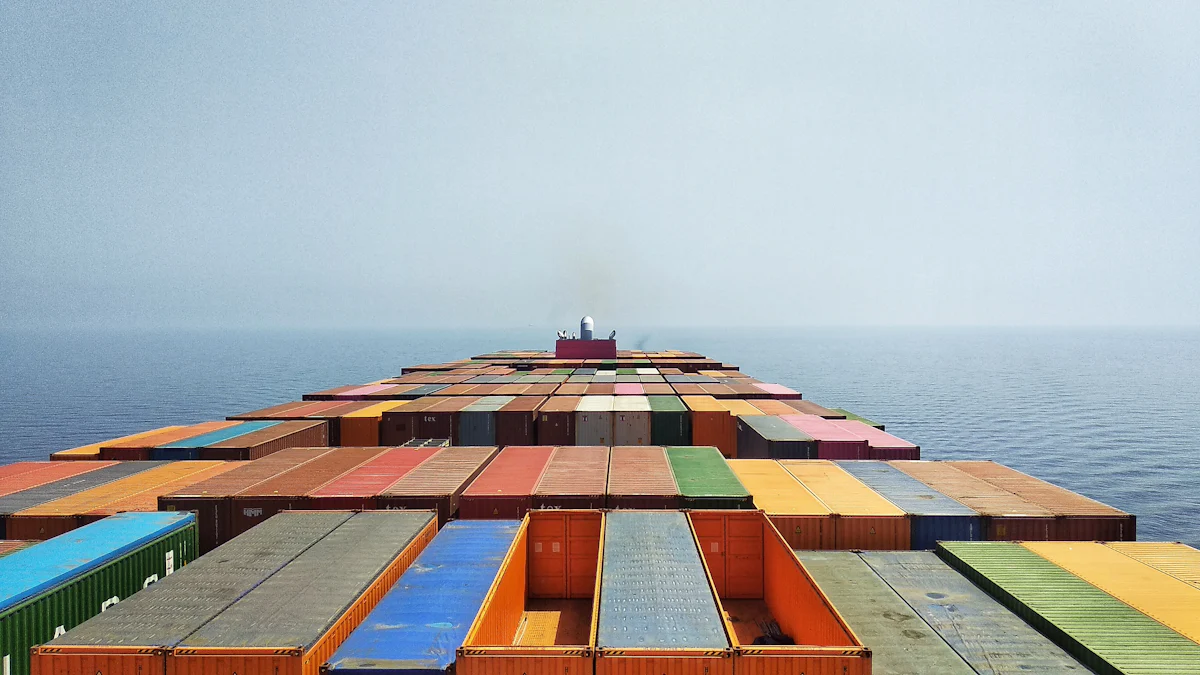How to Understand and Reduce Ocean Freight Destination Fees

Ocean freight destination charges represent a significant part of shipping costs. These include base rates, bunker fuel surcharges, and terminal handling fees. You may find these fees overwhelming, but understanding them is crucial. Poor management of these charges can strain your logistics budget. By mastering them, you can optimize your shipping expenses effectively.
Key Takeaways
Understanding ocean freight destination charges, such as terminal handling and customs fees, is crucial for effective budget management and can help avoid unexpected costs.
Consolidating shipments and negotiating with freight forwarders can significantly reduce destination terminal handling fees, leading to more efficient logistics and lower overall shipping costs.
Planning shipments during off-peak seasons and choosing alternative ports can help you avoid peak season surcharges and high operational fees, optimizing your shipping strategy.
Breaking Down Ocean Freight Destination Charges

Terminal Handling Charges (THC
Terminal Handling Charges (THC) cover the cost of loading and unloading containers at the port. These fees vary depending on the port, cargo type, and services required. For instance, THC for a 20-foot container from Asia to the US averages $550, while shipping to Canada costs around $540. Ports like Shanghai and Tanjong Pagar may charge differently due to variations in technology and services. Understanding these charges helps you plan better and avoid unexpected costs.
Port Congestion Surcharge (PCS)
Port Congestion Surcharge (PCS) compensates for delays caused by overcrowded ports. Shipping lines impose this fee to cover extra fuel consumption, waiting times, and operational expenses. Factors like increased demand, limited port capacity, and unforeseen events contribute to congestion. For example, carriers may charge PCS to offset costs when vessels experience delays at busy ports.
Delivery Order Fee (DOF)
The Delivery Order Fee (DOF) is a charge for issuing the delivery order, which allows you to collect your cargo. This fee ensures smooth coordination between shipping lines and terminal operators. While it may seem minor, it adds up, especially for frequent shipments. Monitoring DOF can help you manage your logistics budget effectively.
Customs Clearance Fees
Customs clearance fees depend on the declared value of goods and vary by country. For example, machines for assembling electric lamps in the US incur no customs duty, while similar items in Nigeria face a 5% duty. These fees also differ based on product type and associated risks. Knowing the customs policies of your destination country can save you time and money.
Other Common Charges (e.g., demurrage, detention, and wharfage)
Demurrage and detention fees arise when containers exceed their free time at or outside the terminal. Demurrage costs range from $50 to $300 per day, while detention fees start at $25 per day. Wharfage fees cover the use of port facilities and vary by location. Keeping track of these charges prevents unnecessary expenses and ensures efficient cargo handling.
Factors Influencing Ocean Freight Destination Charges
Fuel Costs and Surcharges
Fuel costs play a significant role in determining ocean freight destination charges. Shipping companies use a bunker adjustment factor (BAF) to account for fluctuating oil prices. This surcharge updates quarterly to reflect current fuel costs. When oil prices rise, shipping companies pass the increased costs to you through higher surcharges. Since bunker fuel is a major expense in ocean freight, even small changes in oil prices can significantly impact shipping rates. Staying informed about these fluctuations helps you anticipate changes in your logistics budget.
Port Congestion and Delays
Port congestion often leads to higher shipping fees. A mismatch between port capacity and demand causes delays, especially during peak seasons. Increased consumer spending during holidays overwhelms ports, resulting in peak season surcharges. Unforeseen events, such as geopolitical crises, can also disrupt shipping schedules. Inefficient port operations, labor shortages, and strict customs procedures further contribute to delays. These factors increase operational costs, which shipping companies recover by raising fees. Choosing less congested ports or planning shipments during off-peak times can help you avoid these additional charges.
Seasonal Demand and Peak Shipping Periods
Seasonal demand significantly impacts ocean freight destination charges. During peak periods like the holiday season or Lunar New Year, limited vessel capacity drives up shipping rates. Consumer demand surges during these times, leading to higher shipping volumes and peak season surcharges. Planning your shipments outside these periods can help you save on costs. Understanding these seasonal trends allows you to optimize your shipping schedule effectively.
Local Regulations and Taxes
Local regulations and taxes vary by country and directly affect shipping costs. Some countries impose higher customs duties or stricter compliance requirements, which increase overall fees. For example, regions with complex customs procedures may require additional documentation, leading to delays and higher costs. Familiarizing yourself with the regulations of your destination country ensures smoother operations and helps you avoid unexpected expenses.
Type and Volume of Cargo
The type and volume of your cargo also influence shipping fees. Larger shipments or those requiring special handling incur higher costs. For instance, hazardous materials or temperature-sensitive goods need additional safety measures, increasing fees. Consolidating shipments or choosing cost-effective packaging can help you reduce these expenses. Understanding how your cargo type affects charges enables you to make informed decisions and manage costs efficiently.
Strategies to Reduce and Manage Destination Terminal Handling Fees

Negotiate with Freight Forwarders
Negotiating with freight forwarders can significantly lower your destination terminal handling costs. Start by building strong relationships with shipping lines and terminal operators. This approach often leads to better service and reduced fees. Choose efficient ports to minimize handling expenses. Consolidate shipments to reduce the number of handling operations. Stay informed about fee changes to avoid surprises. Use technology to track and manage operations effectively. Optimizing your route planning also helps you select paths with lower terminal handling charges. These strategies ensure you secure a competitive freight quote while managing costs efficiently.
Consolidate Shipments to Reduce Costs
Consolidating shipments is an effective way to reduce overall destination charges. Combining multiple shipments maximizes cargo space utilization, which minimizes handling expenses. This approach also streamlines loading and unloading processes, improving logistical efficiency. By consolidating shipments, you can lower transportation costs and simplify your supply chain operations. This strategy is particularly useful for businesses that frequently ship smaller volumes.
Choose Alternative Ports or Shipping Routes
Selecting alternative ports or shipping routes can help you avoid high destination terminal handling fees. Some ports charge less due to their efficiency or lower operational costs. Researching and choosing less congested ports can save you money and reduce delays. Alternative shipping routes may also bypass regions with higher fees or stricter regulations. This flexibility allows you to optimize your logistics budget while maintaining timely deliveries.
Plan Shipments During Off-Peak Seasons
Shipping during off-peak seasons reduces costs associated with peak season surcharges. Quieter months often provide better container availability, which helps you avoid delays and additional fees. Planning shipments during these periods ensures smoother operations and lower destination charges. Understanding seasonal trends allows you to align your shipping schedule with cost-saving opportunities.
Partner with JUSDA for Comprehensive Supply Chain Solutions
Partnering with JUSDA offers a strategic advantage in managing ocean freight destination charges. JUSDA’s expertise in supply chain management ensures compliance and operational efficiency. The company negotiates better rates with carriers, reducing your transportation costs. JUSDA’s advanced technology provides real-time visibility and analytics, enhancing decision-making. Their scalable solutions adapt to market demands, offering flexibility for your business. By collaborating with JUSDA, you gain access to a robust logistics network and innovative tools to optimize your supply chain.
Tip: Leveraging JUSDA’s JusLink intelligent supply chain platform can further streamline your operations. This platform integrates IoT, cloud computing, and big data to provide real-time insights and improve efficiency.

JUSDA Solutions
To provide you with professional solutions and quotations.
Understanding ocean freight destination charges empowers you to manage costs effectively. Fees like terminal handling charges, which range from $250 to $800 per container, can significantly impact your budget. Proactive planning and negotiation save up to 30% on shipping costs. Partnering with JUSDA ensures streamlined operations, better rates, and innovative tools to optimize your logistics.
See Also
Find Out If You're Spending Too Much on Supply Chain
Exploring the Latest Developments in Sea Freight Logistics
Your Complete Guide to Reducing Logistics Costs
